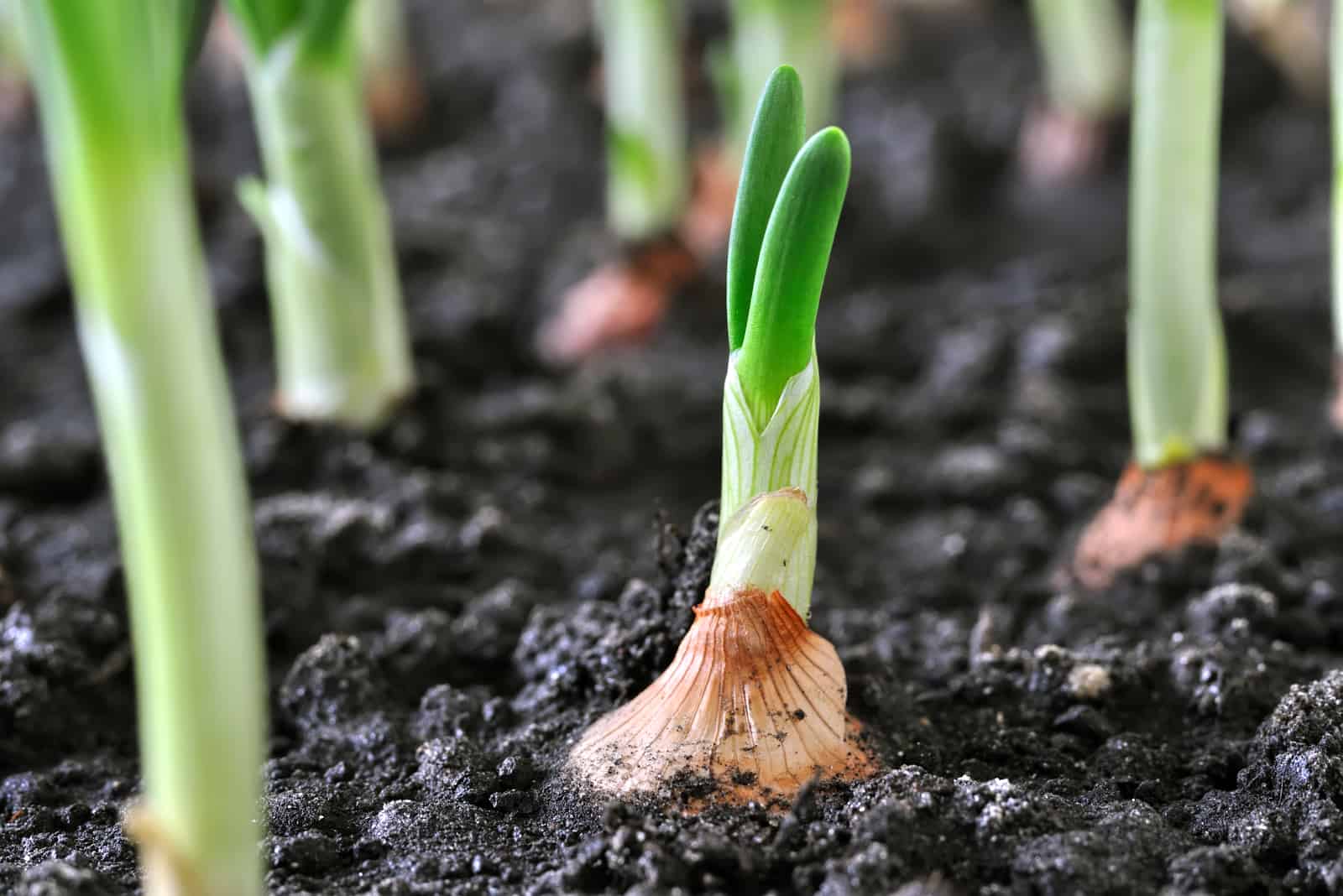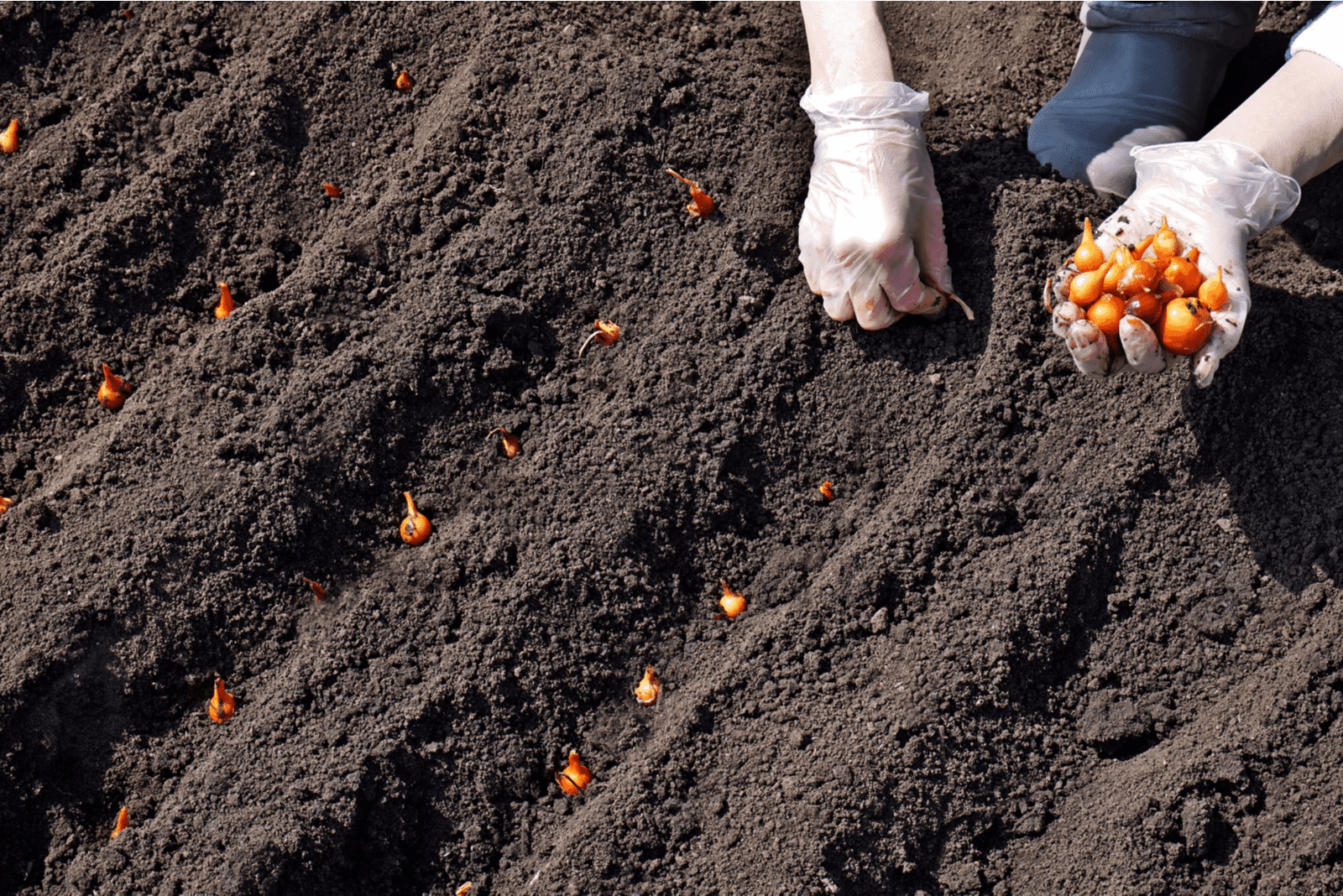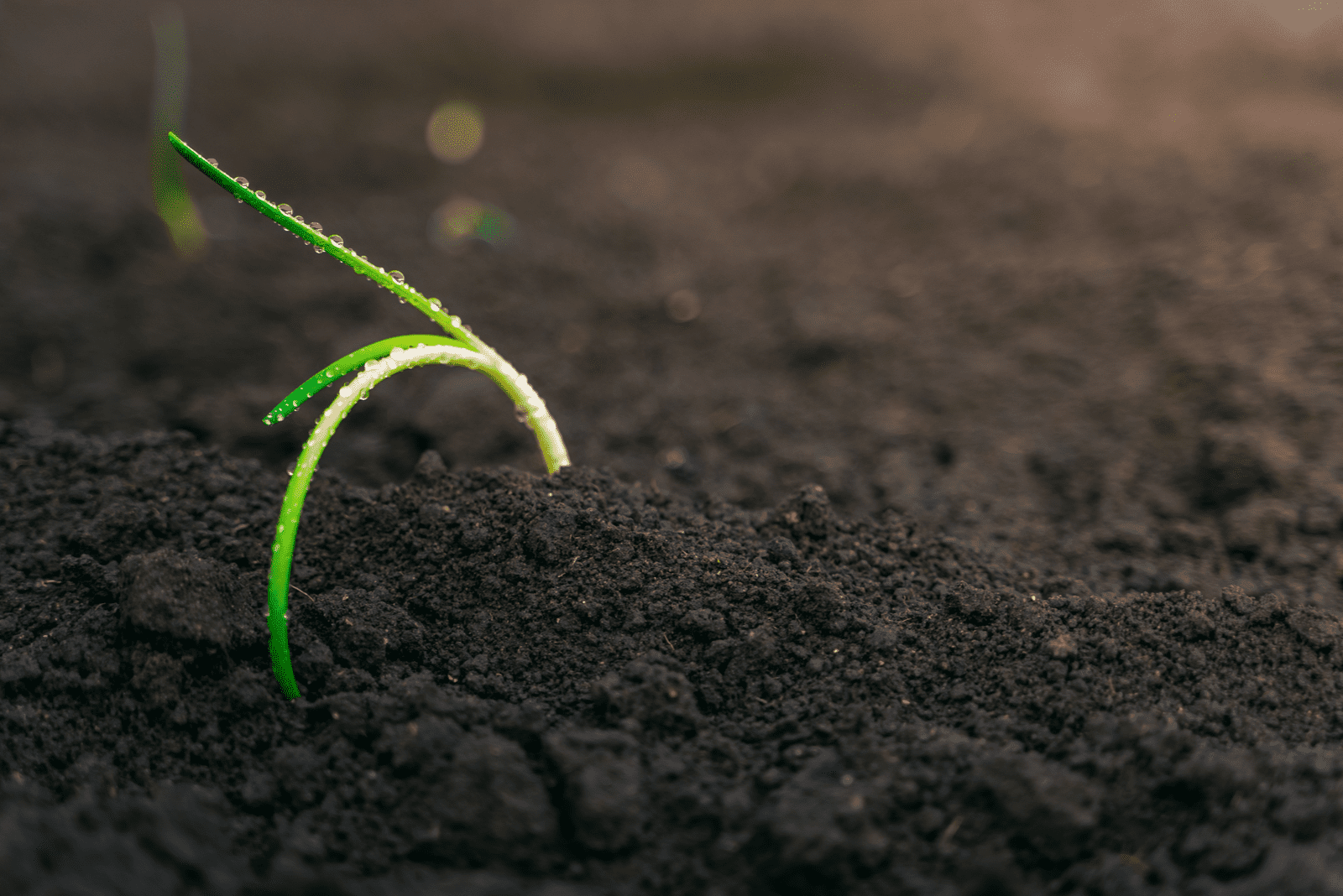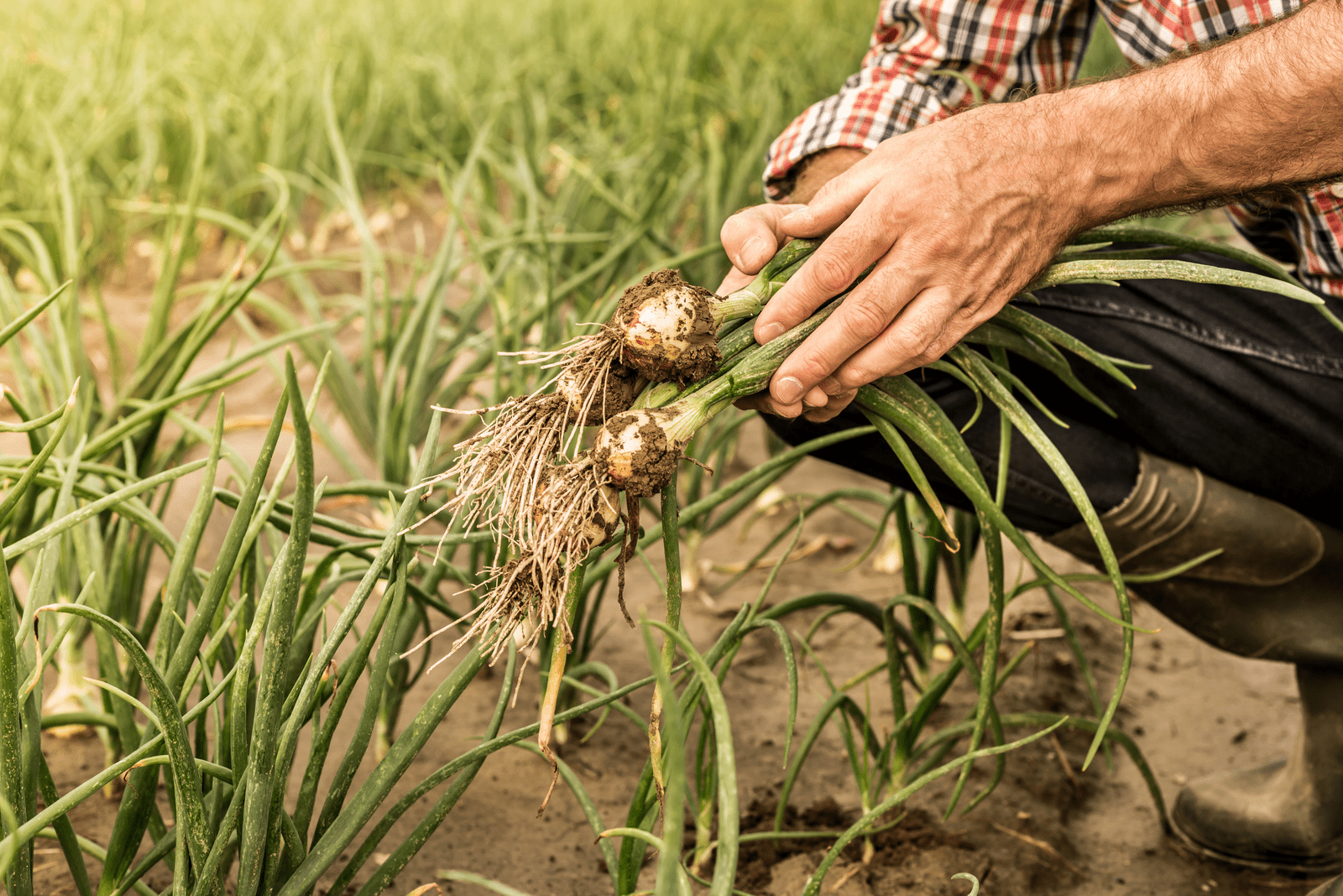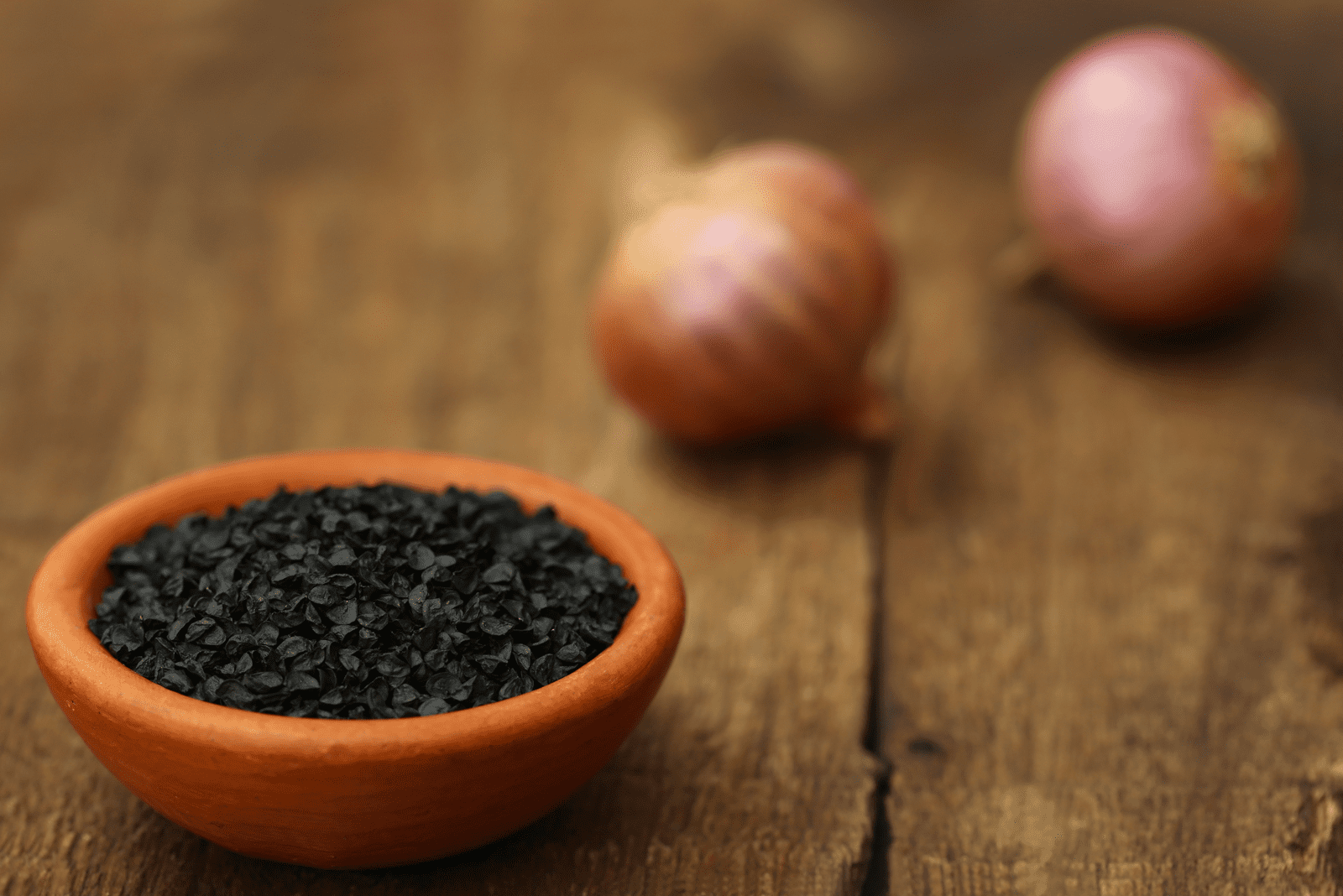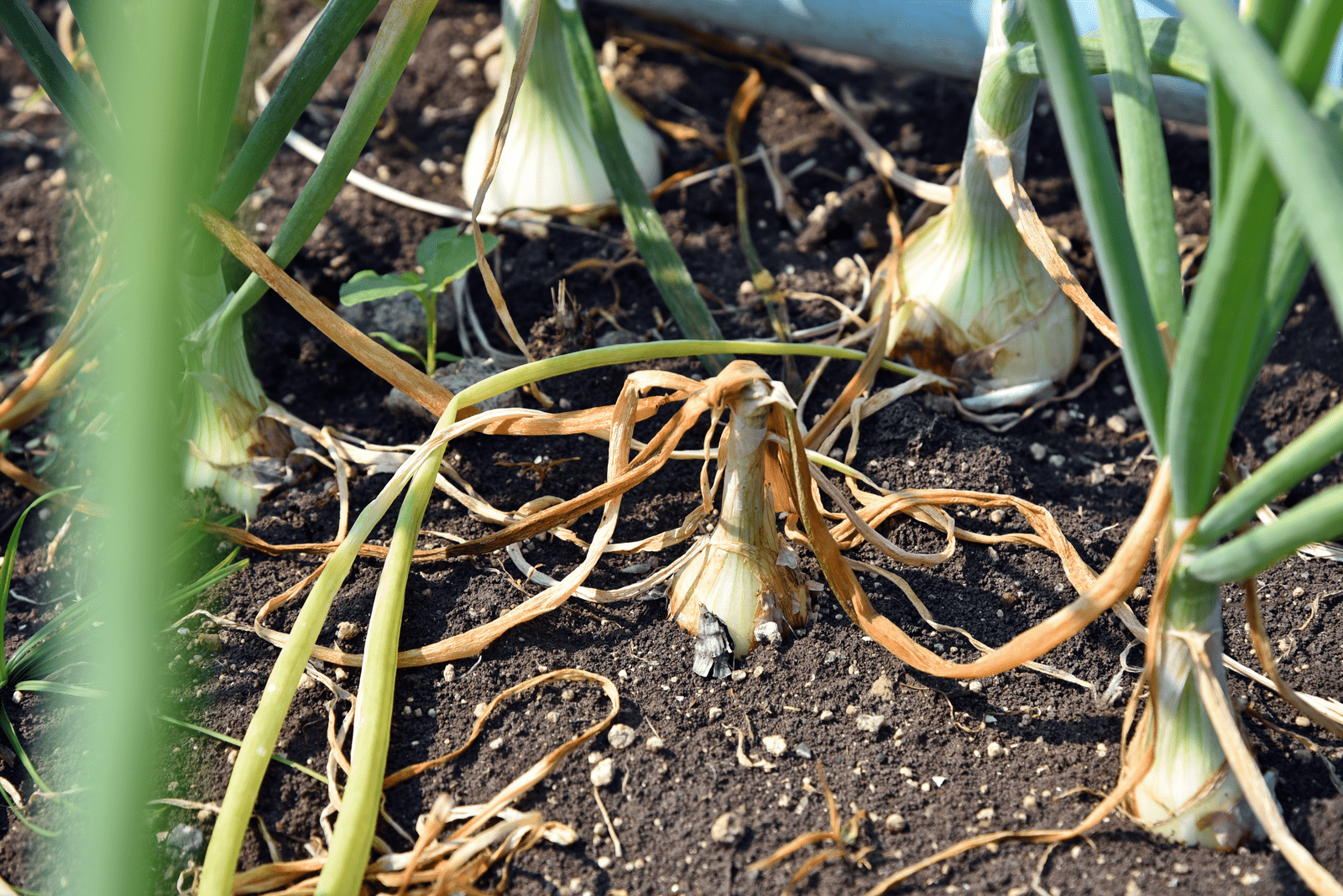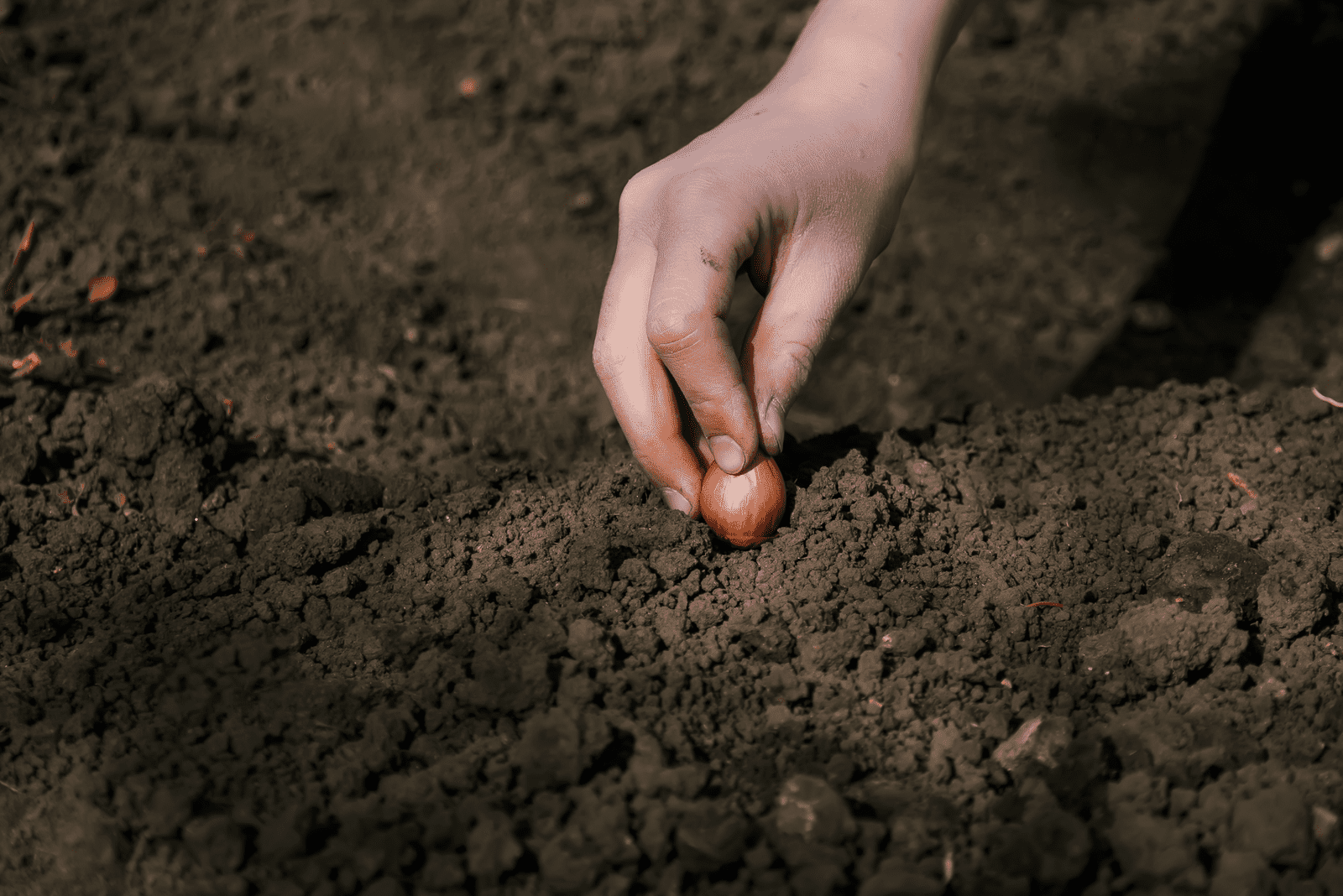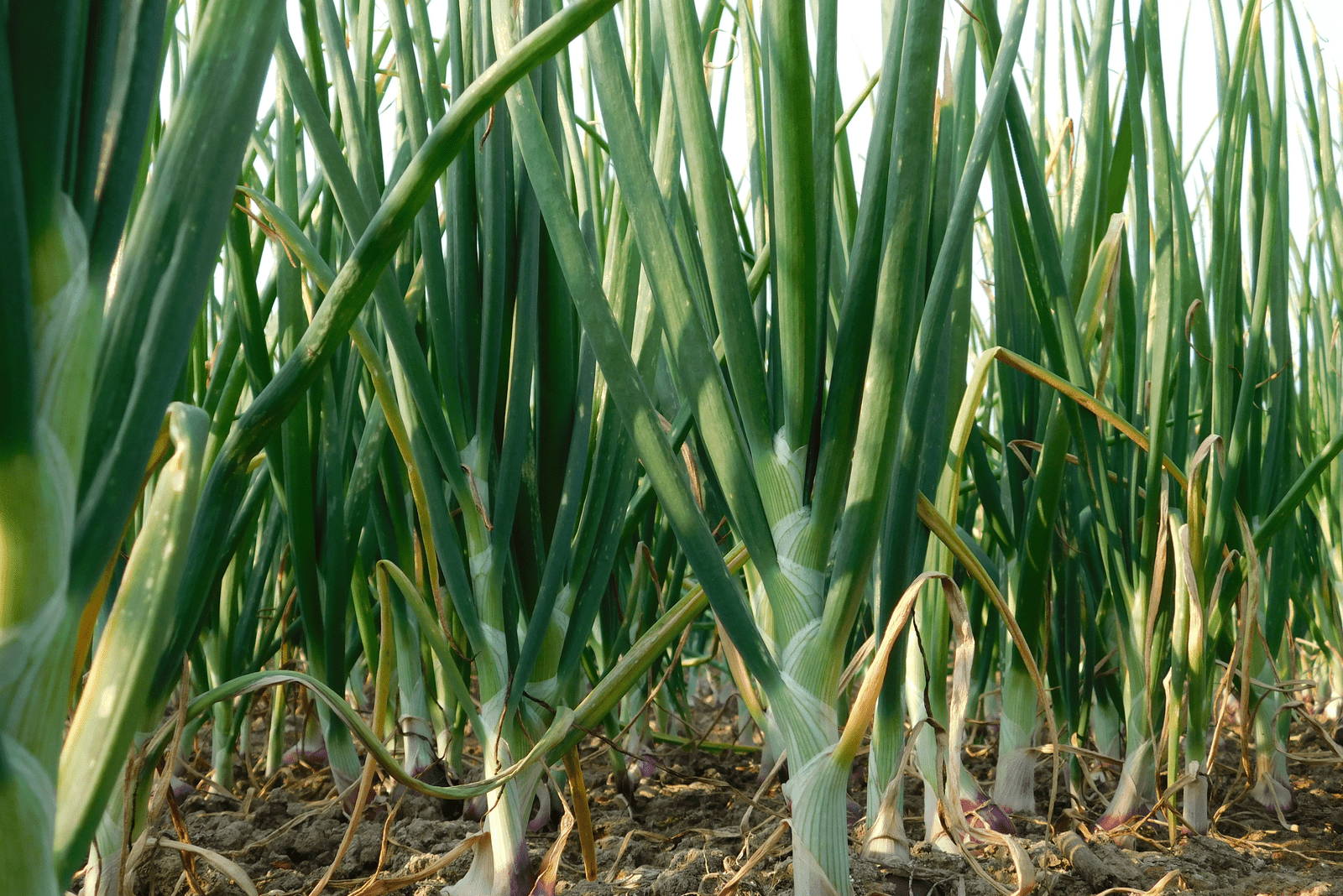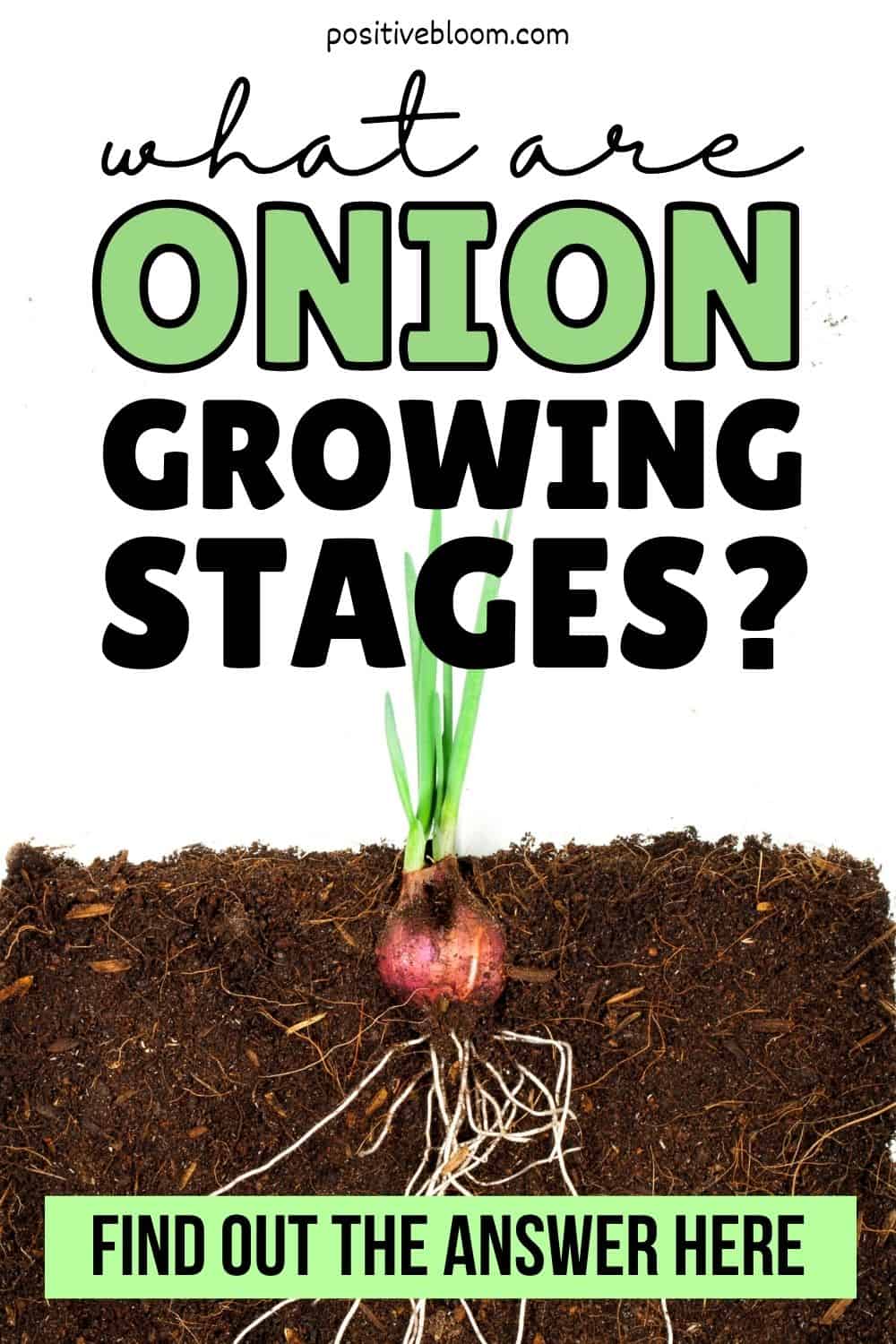It seems like onions are essential in every vegetable garden, and for a few good reasons — not only are they extremely beneficial to our health, but they are also easy to grow!
If you don’t have a large garden, don’t worry, because you can also grow onions in pots and containers (I even use an old car tire to grow them, and yes, I am all about recycling!).
The onion growing stages aren’t visible by our eyes, as they are root vegetables, so the growing and formation of the bulb happens underneath the soil surface; fortunately, we can observe the long, dark green leaves and stalks that come out of the bulb.
It is important to understand these growth stages, so you can deal with any problems that might occur, and enjoy your delicious onions at the end of the growing season!
Now, let’s take a look into an onion life cycle!
What Are Onion Growing Stages?
First of all, you should know that onion plants are biennial — meaning, it takes two years for them to fully develop. Yes, you can eat onions in the first year; but in the following year, they will bloom and produce seeds that can be used to plant onions again.
Now, this depends on your preference. You can continue to take care of your onion plant if you want to use those specific seeds to grow them in the next season, or, you can simply buy new onion seeds and plant them.
In the first year, the onion goes through 10 different growing stages, which include: planting, germination, sprouting, true leaves formation, initiation and development of the bulbs, maturation, and vegetative senescence.
The second year is not so tiring for your onion plant, it only goes through 4 growing stages: vegetative growth, flowering of the stalks, seed formation, and senescence.
1. Planting
We have different planting methods for a few reasons; the first is that you can plant them at a different time, and you can also grow them from seeds, onion sets, or mature plants.
Since onions are cool-season vegetables, they can be planted in early spring to wait for the late summer onion crops, or they can be planted in the fall or late spring. This all depends on the latitudes of your regions: if you live in Northern regions, then you should probably plant it in the early spring, otherwise you can plant them in fall or late spring.
You can immediately start thinking about companion planting – for instance, yarrow is a great companion to your onion, which is why they should be planted together!
Now, let’s dive into different planting methods.
Planting The Seeds
The simplest way for growing onions is planting onion seeds — they are not that expensive, and are easily planted in a raised bed or directly into the soil. Growers tend to build raised beds and rows to yield better crops.
If you live in an area with a cold winter, you can start your plant indoors at least 8 weeks before the last frost date, and then transplant the seedling into the outdoor vegetable garden. You should wait for about 2 or 3 weeks to pass after the last frost, so the soil can warm up and is ready for your onion seedlings!
Planting Onion Sets
Growing onions from onion bulbs is a lot easier when compared to from seeds, as you won’t be needing to start your plants indoors before the last frost has occurred. They are easily planted and quickly established.
Bear in mind that you are not supposed to use bulbs that are too large, as they can produce stiff necks; the most optimal size of planting bulb should be 3/4 of an inch in diameter.
Planting From A Mature Onion Plant
After eating an onion, you should save the bottom part and use it to grow new sprouts instead of putting it in the garbage. They can be planted as transplants into the soil, or you can eat these little sprouts as green onions.
If you decide to plant them in the spring, you should do it in late May or early June; then, put them in raised beds that have temperatures above 28 degrees Fahrenheit, and keep the soil moist.
For fall planting, you can do it in early September or late August, when the temperature is still warm so they can continue growing. During winter, they will go dormant but will proceed on growing once the spring kicks in!
Here is a great video about planting onions that is ideal for beginner gardeners:
2. Seed Germination
Germination should occur in the first 10 days after planting and this process happens underneath the surface. During germination, the outer layer of the seeds will dissolve and radicals will continue developing in the roots and shoots.
The roots are going to grow down and establish a root system, while the shoots are going to come up out of the soil surface to be able to photosynthesize and provide nutrients. This process depends on the temperature and humidity of an area, as well as the type of the soil.
The most optimal soil for growing onions is well-drained soil that is rich in nutrients — clay soil is a big no-no for onions! If your new onion plant does not grow in the most optimal conditions, then this whole process can take a few weeks.
3. Sprouting
Once you notice little shoots coming up out of the soil, as we mentioned earlier, then your new baby onion is developing and sprouting.
This is when your plant shifts its focus to absorb energy from the sun, hence, you should provide it with enough sunlight for growth. At this stage, you should start fertilizing your plant to encourage development and water it frequently to keep the soil moist.
You can apply mulch around the base of the plant: the mulching will help with the retention of moisture, and in weed growth prevention. If you started your plant indoors, at this stage you should transplant it out into your garden.
4. True Leaves Formation
Your sprouts will still rely on nutrients from the soil in order to develop true leaves. Once you see a smaller version of dark green leaves (as you would see on mature onion plants), that means that the true leaves have successfully formed.
Now, your plant solely relies on photosynthesis, and the ability to produce glucose to provide energy for the entire plant. As time goes by, more true leaves will develop and photosynthesis will happen at a much faster pace. They are now referred to as leeks, though they will develop soon into small onions.
In fact, once the stalks have fully developed and got their dark green, sturdy look; the onions are referred to as scallions, green onions, bunching onions, and so on. However, their botanical name, Allium Cepa, stays the same throughout the different onion growing stages!
During this stage, your onion plant will reach its full height, and it should be quickly finished so that bulbs can start developing — the sooner the bulb development begins, the larger the bulb onions will be!
5. Onion Bulb Starts Developing
During this stage, your plant’s main focus is the initiation of the bulb; to assist this process, you should provide it with enough water and nutrients so that the bulbs grow big and strong. A lack of nutrients and dry soil can lead to stunted growth.
Spacing is important as well, since each plant requires its own space for the development of root systems; and if they are too close to one another, they might compete for the nutrients.
How much time it will take to form bulbs actually depends on the variety of onions, asides from the provided conditions. These types of onions can be distinguished by the day length — for instance, short-day onions need from 10 to 12 hours of daylight to form bulbs, while long-day onions need from 14 to 16 hours of daylight (they will produce the largest bulbs!).
And lastly, we have day-neutral types that take from 12 to 14 hours to set bulbs. The majority of onions that are sold are long-day varieties, since they produce the largest bulbs. If your primary goal is not to eat bulbs, rather to eat the green onions, then I suggest you get short-day varieties.
After a while, you will notice small bulbs popping out of the soil surface; this usually indicates that the bulb has developed.
6. Maturation
Bulb formation is just one step in onion plant growth, there are also a few steps that indicate the complete formation of bulbs, as well as flower and seeds production.
If you notice that the leaves kind of fold down, it means that all the resources that were stored at the top of the leaves are now moved to the bottom, which causes the onion bulbs to swell. Once you notice that the onion tops have folded, then it is usually an indicator that your onion is ready to be harvested.
How to properly harvest and store onions
Harvesting onions is not such a hard task, though you should be careful not to damage the onion bulbs, if you are using a digging fork for instance.
So, you can harvest onions using your hands, or you can use a spade or shovel instead. If you are going to pick your onions by hand, then you should loosen up the soil with a digging fork before harvesting.
If you are using a shovel, then you can simply dig them out of the ground — make sure not to damage the onions, nor to cut the stalk attached because they are necessary if you want to store the onions for a long time.
After harvesting, you should leave the onions to cure for a few weeks by simply putting them under sunlight or in a place with a warm temperature. After that, you should cut the stalks, but leave a few inches to prevent them from rotting, and you can store them in a cool and dry place — I personally put them in baskets in my basement.
It is important to harvest them on time, because overripe onions do not taste good and they are much more bitter when compared to regular ones.
7. Vegetative Growth
If you haven’t harvested the onions and have left them in the ground during the winter season, then they will continue growing and developing. Many gardeners don’t know that their onions can survive winter, and eventually produce seeds that can be sown again.
When the springtime comes and the soil starts warming up, a process similar to germination happens. Since the roots are already established, the plant will focus on developing shoots that are going to pop up on the soil surface!
8. Flowering Stalks Appearance
As time goes by, and the temperature starts warming up, the onion plant will continue its growth. After a while, the vegetative growth will stop and the plant will continue growing its flowering stalks.
You will see at the top of the stalks, the buds, and then the flowers will start to grow. They can be differently colored (depending on the type of onions), however, the majority of flowers have a white, green or purple color. This indicates the end of the onion’s life cycle.
9. Seed Production
The flowers on the onion stalks can be pollinated, which indicates seed production. Pollination is done by pollinating insects, like bees and butterflies, or sometimes even small birds.
During seed production, the plant will use all the reserved nutrients from the bulb and use it for formation of the seeds — if you harvest the onion now, the bulbs are going to be woody.
Nonetheless, you can use these seeds to plant onions again in the new growing season! This is done if the harvest is good, and if a certain type of onions is just perfect for your taste.
10. Senescence
During seed production, we have come to the end of the onion growth stages. After the seeds have been produced and all of the energy has been used up, the plant will slowly deteriorate and die.
I personally leave a few onions overwinter to be able to sow the same ones again, however, this is totally up to you! Bear in mind that you won’t be able to start your onion plant indoors if you are waiting for last year’s seed production.
Onion Growing Stages: Common Problems
There is nothing more disappointing than spending so much time taking care of your vegetables, just to end up with damaged crops or no crops at all! Growing root vegetables like beets, carrots, shallots, and onions can be tricky because you never know what is happening beneath the surface of the soil.
However, if there are some issues during different stages, it will reflect on the whole plant, including the part that is above the ground, and you can easily tell what the issue is and how to deal with it.
During the onion growing stages you might notice stunted growth, leaf discoloration, wilting plants, misshapen bulbs, and so on.
Read on to learn how to recognize these issues, and how to prevent them.
Onion Seedlings Drooping
You planted your onion seeds, and they successfully germinate and continue sprouting, so little seedlings appear… but, what to do when they then start wilting and drooping?
Onion seedlings usually start to wilt because of bad insects and worms.
For instance, cutworms are sneaky caterpillars that hide in the soil and then come out at night to eat your plant! They can infect your onion plant as soon as it starts growing, which is why these seedlings tend to wilt and droop.
These annoying little creatures follow the moisture line — if the topsoil is dry, they will go deeper into the soil to find moisture; and as soon as the plant has been watered, they will come out on the surface.
To prevent cutworms, you can put a cardboard collar around the base of onion seedlings, to prevent them from reaching the plant; if they have already been invading your little plant, you can simply pick them and remove them by hand.
Asides from these organic precautions, you can also use pesticides or Bacillus thuringiensis, which is a bacteria that can ingest caterpillars.
Another reason why your onion seedling might be drooping are thrips. Thrips are insects that can not be easily spotted; they usually hide on the underside of the leaves, and feed, causing them to wilt and change to a silver color.
They can eat an entire seedling if they go unnoticed; however, if you do spot any silvery leaves, make sure to use pesticides to get rid of them.
Stunted Growth
A major environmental factor that affects onion growing stages is climate. Many growers tend to plant an onion variety that is not suitable for the climate in their area. Before planting, make sure to buy the right type of onion.
You can either buy the seeds and plant them, or you can grow the onions from sets. It has been detected that onions grown from sets are easier to take care of, and are trouble-free; whereas onions grown from seeds can have certain issues because they are planted directly into the soil, and they stay in the same position until the end of the growing season.
If you planted the wrong kind of onion, you may still get some crops, though they may be smaller in size, and are not as tasteful.
Onion Seedlings Turning Yellow
The reason why onion seedlings might turn yellow is a dangerous fungal infection called white rot. The fungal spores that cause this disease can live up to 15 years in the soil!
The first symptom of this disease is white mold around the base of your little plant, and it disrupts the normal flow of nutrients and energy throughout the entire plant. Next, the leaves start to turn yellow and wilt, which eventually leads to the death of the onion seedling.
The main issue with this disease is that it is easily transferable, and there is no cure for it. So, if you notice white mold or yellowing, quickly remove the plant and put it in a garbage bin. You can also incinerate the infected plant, though you should never use it for composting, as these spores can survive and infect other plants!
This is the reason why onions are usually grown in raised beds, with clean and adequate soil.
Onions Are Not Sprouting
Here, the only reason why your planted onions might not be sprouting are the onion fly maggots. These annoying pests are one of the major issues when it comes to growing onions.
They will lay their eggs at the base of the onion plant, these will eventually turn into maggots that will eat the roots and shoots, and kill the entire plant. This infestation and hatching happens pretty fast, so it is important to remove them as soon as possible.
They are easily recognized: the first indicator of a maggot infestation is wilting and yellowing leaves; then, if you lift the plant, you’ll see those little maggots crawling at the base of the plant or in the soil.
Larger onions will stop growing, while smaller ones can be completely destroyed by these little annoyances.
There is not an actual cure that can save your plant, although you could put fleece down to cover the ground, which prevents them from reaching the onion plant. After the seeds have germinated, and grown into seedlings, there is no threat of onion fly maggot infestation, as they don’t invade established plants.
Onion Plant Is Dying
As we have previously mentioned, the climate is a major environmental factor that influences the onion’s growth. Onions don’t like being exposed to temperature stress and fluctuations, as well as different harsh weather conditions like storms and hails.
The growth can easily be disrupted by too high or too low temperatures. For instance, if the temperature drops down to 23 degrees Fahrenheit, the bulb will be damaged and will turn soggy, which leads to the death of the young onion plant.
Too high temperature can cause early flowering, which results in small onions, and long exposure to direct sunlight can burn the leaves and damage the tissue of the plant, even if it is grown and established.
Strong wind and hails can damage and break the leaves, which makes them more susceptible to different pests and diseases.
Only Zeus, who controls the weather, can help you to save your onions in these harsh conditions, otherwise you can not do anything about it.
Bulbs Are Not Forming
We have already mentioned that the plant focuses separately on bulb formation and on the stalk and flowering — however, there are certain cases when the plant switches its energy from bulb formation to other parts of the plant, leaving the bulb malformed and small.
This can happen due to temperature fluctuations: for instance, if the temperatures are low for a few days, and then extremely high for the next few days; or the reason might be too loose soil or hoeing that has caused root disturbance.
Small onion sets and large onion sets are equally affected by these inconveniences, though gardeners often think that large onions are going to grow without being disturbed.
Onion Plant Wilting
Onion plant might be wilting due to inadequate watering. Too much or too little water can have different effects on your plant, but the main issue is wilting. You should not let the soil completely dry out, though they also don’t prefer growing in soggy soil.
They thrive in moist soil, so you should always check if the topsoil has dried out. If so, then it is time for watering.
You should water your onion plant in the morning so the plant has enough water for the rest of the day, because the water evaporates quickly when the plant is exposed to direct sunlight. Avoid watering at night because the soil will stay soggy for too long, which leads to root rot.
When watering, make sure not to water the leaves because it might make it more susceptible to fungal infections — so you should water directly into the soil.
Frequently Asked Questions
1. How do you know when an onion is grown?
Since the bulb formation happens underneath the surface, it can be tricky to tell when the bulbs are completely formed. However, there are a few signs that indicate full maturity: first, you look at the stalks, if they have turned over at one side, it usually means that the bulb is completely formed.
You might also notice the bulbs coming out of the soil. This is when the onions are usually harvested, though you could leave them to grow for one more year if you want your onion plant to flower and produce seeds.
2. What are the benefits of onions?
Some people might like the taste of the onions, some don’t — however, all of us should eat onions on a daily basis as they are completely packed with antioxidants that can fight cancers and diabetes. They also contain certain fibers and substances that can lower blood pressure and improve high cholesterol, reduce inflammation, and improve bone density.
It is also known that they can support healthy guts, which is why they are often used in diets for folks that want to lose weight. And lastly, they can be used as antibacterial remedies that can disrupt certain bacteria, like Escherichia Coli, Staphylococcus aureus and Pseudomonas Aeruginosa.
3. What conditions do onions need to grow?
Onions are root vegetables that are quite easy to grow, since they do not require any special care. For instance, they need minimal fertilizers as they are not heavy feeders, they prefer well-draining soil with a pH from 6 to 6.8. They can grow in full sun, and it is best to grow them in raised beds so that they don’t get infected by various fungi in the soil.
They don’t like temperature fluctuations, and they prefer temperatures within a range of 55 to 75 degrees Fahrenheit. They should be watered thoroughly, and they like having moist soil, so you should always check if the soil has dried before watering — if it is dry, then it is time to water.
4. What is the average height of a grown onion?
The height of an onion plant differs between different types of onions, however, the average height of a grown onion is 20 inches tall, and 15 inches wide; while the bulbs tend to grow up to 6 inches in diameter (this also depends on the variety of an onion).
To Sum Up
There are 10 onion growing stages that your root vegetable will go through — since some of them happen beneath the soil surface, it is hard to tell whether everything is going as planned.
However, you can always pay close attention to the upper part of the plant, the part that is growing above the soil surface, and see if any wilting or discoloration has occurred. If so, then there may be certain issues present regarding inadequate watering and temperature fluctuations, or, there might be pests or fungi infestations.
If you notice any signs of fungal infections or disease, remove that onion plant immediately to prevent spreading the infection to other plants.
And lastly, these problems do not appear that often, and they can be easily fixed. Onions are great vegetables, packed with antioxidants and fibers that are super beneficial to our health, and they should be grown in every vegetable garden!
If you are also interested in growing carrots, check out these carrot growing stages for more information about planting and growing habits.
Until next time!
Like this post? Share or pin it for later!

